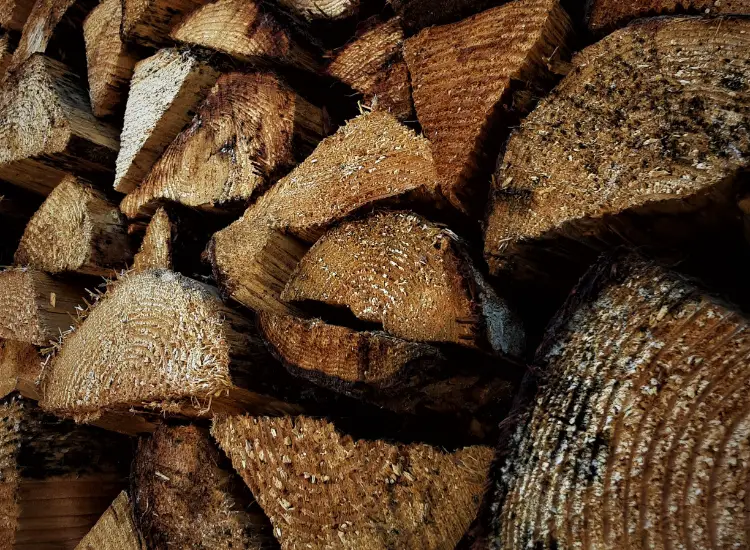How to Get Rid of Mold on Firewood: A Complete Guide

Have you ever wondered how to get rid of mold on firewood? It can be quite frustrating when you’re ready to enjoy a cozy fire, but your firewood is covered in mold. But fear not, because I’ve got some tips and tricks to help you banish that pesky mold and get your firewood ready for a roaring fire!
Mold on firewood is actually common problem, especially if you live in a humid climate or if your firewood has been stored in a damp area. Not only is it unsightly, but it can also affect the quality of your firewood and the air in your home when you burn it. In this article, I’ll explain why mold grows on firewood, the potential risks associated with it, and most importantly, how to get rid of it once and for all.
Quick Links
Why is Mold on Firewood a Problem?
Mold on firewood can be a common issue, but it is important to address it promptly as it can cause several problems. Mold growth on firewood can lead to the spread of mold spores, which can trigger allergies or respiratory issues in individuals who are sensitive. In addition, mold can also damage the firewood, making it less effective as a fuel source and potentially affecting the quality of the fire.
Moldy firewood can also introduce excess moisture into the indoor environment when burned, leading to increased humidity levels and potentially promoting the growth of mold in the surrounding areas. Therefore, it is crucial to take steps to prevent and eliminate mold on firewood to ensure a safe and enjoyable fire experience.
Identifying Mold on Firewood
- Visible discoloration: Mold often appears as patches of green, black, or white growth on the surface of firewood.
- Fuzzy or powdery texture: Mold on firewood may have a fuzzy or powdery texture, similar to the texture of bread mold.
- Musty odor: Mold-infested firewood may emit a musty or earthy smell, indicating the presence of mold growth.
- Soft or decaying wood: Mold can cause firewood to become soft, spongy, or decayed, making it easier to break apart.
- Visible spores: In some cases, mold may produce visible spores that can be seen as small dots or specks on the surface of the firewood.
It is important to identify and address mold on firewood promptly to prevent it from spreading and to avoid potential health issues. If there is no mold present, but the wood looks damaged, the wood can also simply be rotting – without mold being present.
Preventing Mold on Firewood
To ensure that your firewood remains free of mold, it’s important to take certain precautions and follow proper storage practices. Here are some tips to prevent mold growth on firewood:
- Choose seasoned firewood: Go for firewood that has been properly seasoned and dried. Seasoned firewood has lower moisture content, reducing the risk of mold growth.
- Store firewood off the ground: Keep your firewood elevated off the ground, using a firewood rack or pallets. This helps minimize moisture absorption and allows for better air circulation.
- Stack firewood properly: Stack your firewood in a neat and orderly manner, ensuring that the pieces are not tightly packed together. Leave gaps between the wood to promote airflow and drying.
- Keep firewood covered: Protect your firewood from rain, snow, and excessive moisture by covering it with a waterproof tarp or firewood cover. Make sure the cover extends over the entire stack and is securely fastened.
- Avoid storing firewood indoors: While it may be tempting to bring firewood indoors for convenience, it’s best to store it outdoors. Storing firewood indoors can introduce moisture and increase the risk of mold growth in your living space.
- Rotate your firewood supply: Use the “first in, first out” principle when using your firewood. Prioritize using older wood first to prevent it from sitting for extended periods and potentially developing mold.
By following these preventive measures, you can maintain mold-free firewood and ensure a cozy and enjoyable fire experience.
Removing Mold from Firewood
Mold on firewood can not only be unsightly, but it can also impact the quality of the fire and release harmful spores into the air when burned. It is important to remove mold from firewood before using it to ensure a safe and efficient fire. Here are some steps you can take to remove mold from firewood:
- Identify and separate affected wood: Inspect the firewood and identify any pieces with visible mold growth. Separate the affected wood from the rest to prevent the spread of mold.
- Wear protective gear: Mold spores can be allergenic or irritants, so it is advisable to wear gloves, a mask, and eye protection while handling moldy firewood.
- Brush off visible mold: Use a stiff brush or broom to remove any visible mold on the surface of the firewood. Brush in a well-ventilated area to minimize the inhalation of mold spores.
- Scrub with a disinfectant solution: Mix a solution of water and bleach or hydrogen peroxide. Scrub the moldy areas of the firewood using a brush or sponge soaked in the disinfectant solution. This helps kill the mold and prevent its regrowth.
- Dry the firewood: Place the scrubbed firewood in a well-ventilated area to dry. Proper drying helps prevent the return of mold and ensures the firewood burns efficiently.
- Store the firewood properly: Store the dry firewood in a covered and elevated area, away from moisture. This helps prevent the growth of new mold on the firewood.
By following these steps, you can effectively remove mold from firewood and ensure a safer and more enjoyable fire experience. It is also important to monitor the firewood storage area to prevent future mold growth and maintain the quality of the firewood.
Storing Firewood to Prevent Mold
Properly storing firewood is essential to prevent mold growth and ensure that the wood remains dry and suitable for burning. Mold can thrive in damp and humid conditions, so taking the necessary precautions can help keep your firewood free from mold contamination. Here are some tips for storing firewood to prevent mold:
- Elevate the firewood: Place the firewood on a raised platform or pallet to keep it off the ground. This helps prevent moisture from seeping into the wood and promotes air circulation.
- Stack wood loosely: Stack the firewood loosely, leaving gaps between the logs. This allows for better airflow and helps the wood dry more quickly, reducing the chances of mold growth.
- Choose a sunny and well-ventilated location: Select an area that receives ample sunlight and has good air circulation. Avoid storing firewood in damp or shaded areas, such as against a building or under trees, as these conditions can promote mold growth.
- Cover the top: Use a tarp or firewood cover to protect the top of the stack from rain or snow. Ensure that the sides of the stack are still open to allow for proper ventilation.
- Keep the wood dry: Avoid exposing the firewood to excessive moisture. If the wood gets wet, allow it to dry thoroughly before stacking it with the rest of the firewood.
- Rotate the stock: Use the oldest wood first and continuously rotate the stock to ensure that it stays dry and mold-free.
By following these guidelines, you can effectively store firewood and minimize the risk of mold development. Remember to inspect the wood regularly and remove any moldy pieces promptly to prevent further contamination.
Using Firewood with Mold
When it comes to using firewood, it is important to be aware of any mold that may be present. Mold on firewood can have negative effects on both your health and the quality of the indoor air when burned. Here are some considerations to keep in mind when dealing with firewood that has mold:
- Determine the extent of mold: Assess the amount of mold present on the firewood. If there are only a few small patches, it may be possible to remove them without a significant impact. However, if the firewood is heavily moldy or has a strong musty odor, it is best to avoid using it altogether.
- Protect yourself: Whenever handling moldy firewood, it is important to protect yourself. Wear gloves, a mask, and long sleeves to minimize your exposure to mold spores that can be released into the air.
- Keep moldy firewood outside: If you decide to keep the moldy firewood, do not bring it indoors. Instead, store it in a well-ventilated area outside to prevent the mold spores from spreading throughout your home.
- Avoid burning moldy firewood: Burning moldy firewood can release mold spores and other harmful particles into the air. This can lead to respiratory issues, allergies, and other health problems. It is best to use only dry, clean firewood for your indoor fire.
By being mindful of mold on firewood and taking appropriate precautions, you can ensure a safe and pleasant experience when using firewood for heating or recreational purposes.
Safety Precautions When Handling Moldy Firewood
- Wear protective gear: When handling moldy firewood, it’s important to protect yourself. Wear gloves, a mask, and safety glasses to avoid direct contact with the mold and its spores.
- Avoid inhalation: Mold spores can cause respiratory issues, so try to minimize your exposure. If possible, work in a well-ventilated area or use a respirator mask.
- Keep it outdoors: It’s best to handle moldy firewood outside to prevent the spread of mold spores in your living spaces. Avoid bringing it indoors or storing it in enclosed areas.
- Use a tarp or plastic sheet: Before handling the moldy firewood, lay down a tarp or plastic sheet to create a designated work area. This will help contain any mold spores and make cleanup easier.
- Inspect for other hazards: While dealing with moldy firewood, be mindful of potential hazards such as insect infestations, rot, or sharp objects hidden in the wood.
- Thoroughly clean up: After handling the moldy firewood, make sure to clean up the area properly. Dispose of the tarp or plastic sheet, wash your hands and any tools used, and vacuum or sweep the area to remove any remaining mold spores.
It’s important to prioritize your safety when handling moldy firewood. If you have concerns or are unsure about handling moldy firewood yourself, it’s recommended to seek professional help or consult with a local firewood supplier for assistance.
Disposing of Moldy Firewood
If you have moldy firewood, it is important to handle and dispose of it properly to prevent the spread of mold spores and protect your health. Mold can cause respiratory issues and allergic reactions, so it’s important to take the necessary precautions. Here are some steps to help you safely dispose of moldy firewood:
- Do not burn the moldy firewood: As mentioned previously, burning moldy wood can release mold spores into the air, which can be harmful when inhaled.
- Wear protective gear: Before handling the moldy wood, wear gloves, a dust mask, and protective eyewear to minimize your exposure to mold spores.
- Seal the moldy wood: Place the moldy firewood in heavy-duty garbage bags and seal them tightly to prevent the mold spores from spreading.
- Dispose of the wood safely: Check with your local waste management authorities to determine the proper method of disposal for moldy wood in your area. They may require you to take it to a specific facility or arrange for a special pickup.
- Prevent future mold growth: To prevent mold from growing on your firewood, store it in a dry, well-ventilated area off the ground. Avoid stacking wood directly against walls or in areas with high humidity.
By following these steps, you can safely dispose of moldy firewood and minimize the risk of mold exposure in your home.
Conclusion
Mold on firewood can be a common issue that can cause various problems, from triggering allergies to damaging the wood and affecting the quality of the fire. However, by following preventive measures and taking steps to remove and store firewood properly, you can prevent and eliminate mold growth.
It’s important to prioritize your safety when handling moldy firewood and to properly dispose of it to prevent the spread of mold spores. By being proactive and mindful, you can ensure a safe and enjoyable fire experience while keeping your home free from mold contamination.






